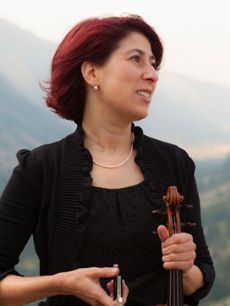|
Chamber
FAMILIAR AND NEW - TRIO NAVARRO'S SPRING CONCERT IN WEILL
by Terry McNeill
Sunday, April 21, 2024
Symphony
MONUMENTAL MAHLER 5TH IN SO CO PHIL'S SEASON ENDING CONCERT
by Terry McNeill
Sunday, April 14, 2024
Chamber
OAKMONT SEASON CLOSES WITH STRAUSS' PASSIONATE SONATA
by Terry McNeill
Thursday, April 11, 2024
Chamber
MORE GOLD THAN KORN AT ALEXANDER SQ CONCERT
by Terry McNeill
Sunday, April 7, 2024
Choral and Vocal
VIBRANT GOOD FRIDAY REQUIEM AT CHURCH OF THE ROSES
by Pamela Hicks Gailey
Friday, March 29, 2024
TWO OLD, TWO NEW AT THE SR SYMPHONY'S MARCH CONCERT IN WEILL
by Peter Lert
Saturday, March 23, 2024
Chamber
NOT A SEVENTH BUT A FIRST AT SPRING LAKE VILLAGE CONCERT
by Terry McNeill
Wednesday, March 20, 2024
THIRTY-THREE PLUS VARIATIONS AND AN OCEAN VIEW
by Terry McNeill
Saturday, March 16, 2024
Choral and Vocal
A ST. JOHN PASSION FOR THE AGES
by Abby Wasserman
Friday, March 8, 2024
Choral and Vocal
SPLENDID SCHUBERT SONGS IN SANET ALLEN RECITAL
by Terry McNeill
Saturday, March 2, 2024
|
 |
 Violinist Polina Sedukh |
UNFINISHED AND FINNISH
by Terry McNeill
Sunday, December 8, 2019
Having a new resident conductor on the podium for the Ukiah Symphony was an attractive invitation for a long-delayed visit to Mendocino College’s Center Theater Dec. 8. The insouciant Les Pfutzenreuter recently retired after decades of conducting the ensemble, replaced by Phillip Lenberg who also joined the College faculty. Clearly it was time to hear how the USO would sound under different leadership.
The initial answer was problematical, as the two Sibelius Valses (Romantique, Op. 62b, and Triste, Op. 44, No. 1) received lackluster performances with spotty attacks and shaky string pitch. The tempos Mr. Lenberg selected were quite slow and even the ever-popular Triste lacked lift and charm. Yes Triste’s character is sad, but sad with flow and subtle momentum.
So it was a pleasant surprise to hear the conductor draw from his orchestra a convincing interpretation of Schubert’s 8th Symphony (“Unfinished”), a two-movement work from the early 1820s. Here attacks and releases were lucid and there was exemplary brass playing throughout, the horns augmented in this concert by three Sonoma County Philharmonic players. The opening section was properly mysterious and even ambiguous, and there was fine thematic playing from clarinetist Nick Xenelis and oboist Beth Aiken over murmuring strings. The big Fortissimo chords were gripping, the conductor controlling section balances and underscoring the work’s violence with just a touch of warmth in the famous second theme played pianissimo.
The E Major Andante second movement was equally effective, beginning with the theme from cello and bass sections, and lovely wind playing with Mr. Lenberg sculpting a chaste oboe ritard before a second theme that was first introduced by the violins. The USO played wonderfully softly at the end, capturing the spiritual calmness of music that at times had strange outbursts and keys far from E Major.
Following intermission came Sibelius’ D Minor Violin Concerto with soloist Polina Sedukh. Playing from score Ms. Sedukh’s focused and shimmering opening phrases were perfectly taken up by the Orchestra, and her bright violin sound, accurate pitch and fast trills had the character needed for this magisterial work from 1905. Her sound was more persuasive in the lower register, but her command of changing vibrato and double stops was artistic. Her sonic power in the long Cadenza was ample.
In the Adagio there are two places were short ascending violin phrases, each ending in a repeat, each repeat best played at less volume and perhaps with a tiny ending ritard, are key to a stellar performance. Ms. Sedukh played both beautifully, as she did with the movement’s final notes, piano and sans vibrato. Elegant playing.
Occasionally in the finale the Orchestra played too loudly, covering the violin line. The soloist caught the intensity of the composer’s writing that in the Orchestra featured resonant trombones and horns. The violin part is virtuosic, at several places dropping from a stratospheric F-Sharp to a low beginning phrase of 13 ascending thirds, marked staccato. Many famous soloists can’t make the fall off, either delaying or slurring the marked upward staccato notes. Ms. Sedukh managed these demanding phrases with aplomb and deft authority.
The Allegro’s last chords brought a standing ovation from the audience of 300, with two curtain calls.
Since Classical Sonoma last attended USO concerts, extra-musical details have all been upgraded – marketing, printed programs, lobby food, the ever-present raffle and gratis entry to the adjacent art gallery. All seems to bode well for a successful tenure for Mr. Lenberg with his seasoned Orchestra.
Daniel Greenhosue contributed to this review.
|

